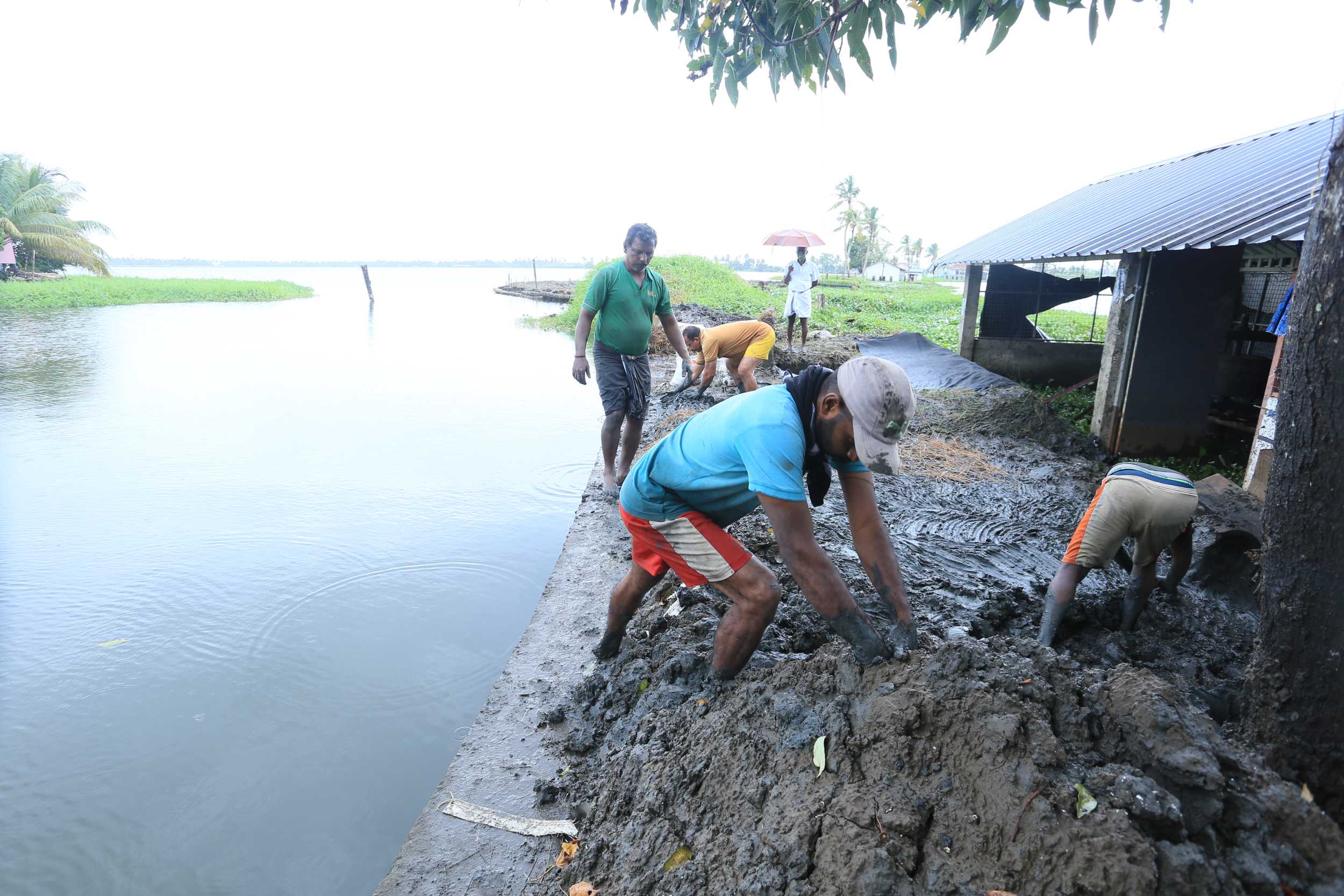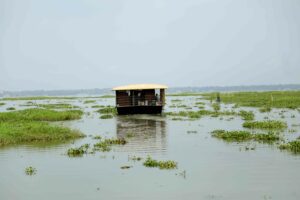Failure to effectively implement the Kuttanad Package, drawn up by Dr MS Swaminathan, has contributed to the crisis in Kerala's rice bowl.

A breached bund in Kuuttanad is geting repaired by locals. Photo: Syed Shiyas Mirza.
A sinking feeling grips Kuttanad in Kerala each time the skies open up.
Located two metres below the sea level, the waterlogged agriculture region spread over 1,10,000 hectares is prone to flooding. Home to more than 1.8 million people, Kuttanad — the lowest point in India — is one of the few places in the world where farming is taken up below the sea level.
With climate change and human factors like unscientific infrastructural projects aggravating the woes, many agrarian families have left Kuttanad, Kerala’s rice bowl, and migrated elsewhere in the state.
The alarming level of migration has left most islets in Kuttanad into ghost villages, providing an eerie feeling as one navigates the backwaters that empty into the Vembanad lake, Kerala’s highly polluted Ramsar site.
According to official figures, 30,000 people from more than 6,000 families have left Kuttanad and become climate refugees elsewhere.
It was the situation that Dr MS Swaminathan, the architect of the Indian Green Revolution, had feared. He had often wondered loud whether we would become climate refugees.
Swaminathan, who passed away in Chennai on 28 September, hailed from Mankombu in Kuttanad, and the region was dear to him.
Experts and the local community blame the government for failing to implement the ₹1,840 crore Kuttanad Package, also known as the Swaminathan Package, aimed at mitigating the agrarian distress in the regional ecosystem.
Approved by the Union government in July 2008, the package emphasised the need for declaring the fragile wetland system a “Special Agricultural Zone”. Dr Swaminathan, who drew up the package, also wanted efforts to prevent large-scale reclamation and encroachment of Kuttanad’s backwaters and canals and demarcate the boundaries of the Vembanad lake and waterways.
Despite spending several crores, nothing concrete has come up in Kuttanad.
The region has abundant water because it is served by the state’s major rivers, Pampa, Meenachil, Achankovil, and Manimala, in addition to the Vembanad lake, India’s second-largest wetland ecosystem. For visitors from outside, the region is the backwater hub.
Luxury houseboats occupy the Vembanad lake, and several canals meander through Kuttanad. Numerous cottages and eateries dot the islets, offering authentic local cuisine. Most inhabitants are poor agricultural workers, who do not own rice fields.
Dr KG Padmakumar, special officer and director of the Kuttanad-based International Research and Training Centre for Below Sea-Level Farming, agreed that several families are now abandoning the region due to recurring floods.
Local people recalled how Dr Swaminathan prepared the detailed package by touring the whole region and interacting with most of them despite his ailing health.
In the report, he explained how ecological changes adversely affected the agriculture, food production, and security of Kuttanad.
“The proposed package was all-encompassing. It addressed all key issues, including the climate challenge, changes in farming, and agricultural economics in flood-prone areas. The package failed to save Kuttanad largely because of the lack of coordinated efforts between various government departments. They, however, independently spent money without having a collective, result-oriented approach,” local farmer P Sisupalan told South First.
“After the Kerala floods of 2018, I left Kuttanad with my family. We had been facing at least half a dozen floods a year. Now, houses and agricultural land are submerged in saline water for a long time. How can we cook and eat in a kitchen inundated with smelly, salty water? Nights are fearful as water can enter at anytime without warning. During heavy rains, the outer bunds of the paddy fields breach, posing a threat to lives,” KV Santhosh explained.
An electrician, Santhosh told South First that he has purchased a piece of land at Poojaveli in Cherthala some 30 km away. He has built a house there. He also blamed the poor implementation of the Swaminathan package for the predicament of those remaining in Kuttanad.
However, not all could leave Kuttanad, like in the case of Vinodini Raju. Along with her husband, she had constructed a house by availing a bank loan at Kanakaseri in Kainakary. The house, including the toilet, mostly remains inundated almost throughout the year.
Revenue officials confirmed that affluent families are buying land outside Kuttanad and moving out. Most people are migrating to Cherthala, Alappuzha, and Changanassery. Low-income people, however, are forced to stay back.
Experts said the unscientific construction of tourism resorts, roads, bridges, and other infrastructure facilities has contributed to the present situation in Kuttanad. The lack of proper river and backwater management is worsening the situation.
“A key issue in implementing the Kuttanad package was its lack of unified focus. We believe that much of the public dissatisfaction over the Kuttanad Package is due to this lack of coordination between departments,” Kerala State Planning Board said in its post-flood 2019 report.
As recommended by Dr Swaminathan, the Union government approved a ₹1,840-crore package for flood mitigation, conservation of ecology, and enhancing agriculture production in July 2008. However, the project remained shelved until 2016 because of the lackadaisical attitude of the Union and state governments, different departments, and stakeholders.
Despite raising the estimate to over ₹2,509 crore and extending the implementation period, nothing concrete happened at the grassroots level. Meanwhile, the indiscriminate and unscientific construction of roads and bridges complicated waterlogging.
As per estimates, hardly ₹398.78 crore had been spent on the package recommendations, though the Union government has released ₹517.27 crore. No steps were taken to get the rest of the amount and utilise it responsibly.
“In the case of the money utilised, the focus was on protecting vested interests that were keen on short-term benefits. Many outer bunds were constructed using the concrete pile-and-slab system, severely affecting the fragile ecology. The funds were spent on projects that were proposed in the package. The benefits have not yet reached the farmers or the marginalised,” local activist VN Jayacchandran said.
Dr Swaminathan had recommended the concrete piling system to bolster the outer bund.
MV Antony, secretary of the Save Kuttanad Forum, opined that though Dr Swaminathan had put in a lot of effort to address the issues, the government’s lack of commitment made those efforts futile and led to rampant corruption.

Discharges from the numerous houseboats and waste disposal by nearby local bodies have contributed immensely to the present situation. (Shafeeq Thamarassery)
“We must create a Kuttanad Regeneration Symphony with all actors playing their part in coordination with each other. Saving the Kuttanad ecosystem and the regeneration of the agriculture of this area has to be a joint Centre-state responsibility,” Dr Swaminathan wrote years ago.
“Climate change is now getting aggravated along with the aftereffects of wrong notions of development. Nobody knows how long this place will remain habitable without any measures to protect the low-lying areas. Those people with nowhere to go are forced to live here,” Jayachandran said.
Ironically, Kuttanad also faces acute drinking water shortage though it is surrounded by water. Piped water is available hardly two times a week, that too for an hour, and often at night. So people are forced to buy drinking water by travelling to faraway locations in their country boats.
In most parts of Kuttanad, sewage is released into the canals from which people draw water for drinking and cooking. In many households, toilets open into the numerous canals and streams of the backwater system. In some areas, villagers drink a kind of dark, oily pesticide-laced water from the paddy fields.
Solid wastes from the medical college hospitals at Alappuzha and Kottayam, sewage from the municipal towns of Kottayam, Cherthala, Thiruvalla, Changanassery, and Alappuzha, and oil and faecal wastes from about 300 houseboats crisscrossing the backwaters are dumped into the Vembanad lake.
During the famous Sabarimala pilgrim season, the Pampa river becomes a sewage drain.
According to the surveys conducted by a Kozhikode-based government agency, the Centre for Water Resources Development and Management (CWRDM), about eighty percent of the people in Kuttanad rely on contaminated canal water for their daily requirements.
“Without remedial measures, Kuttanad will become a victim of misplaced and impractical developmental priorities. The backwaters are vanishing fast because of climate change and human interventions. The government must evolve strategies involving the spirit of human coexistence with water and low-lying areas. it would be the perfect homage to Dr Swaminathan,” Dr Padmakumar said.

May 17, 2024

May 16, 2024

May 16, 2024

May 16, 2024

May 16, 2024

May 15, 2024